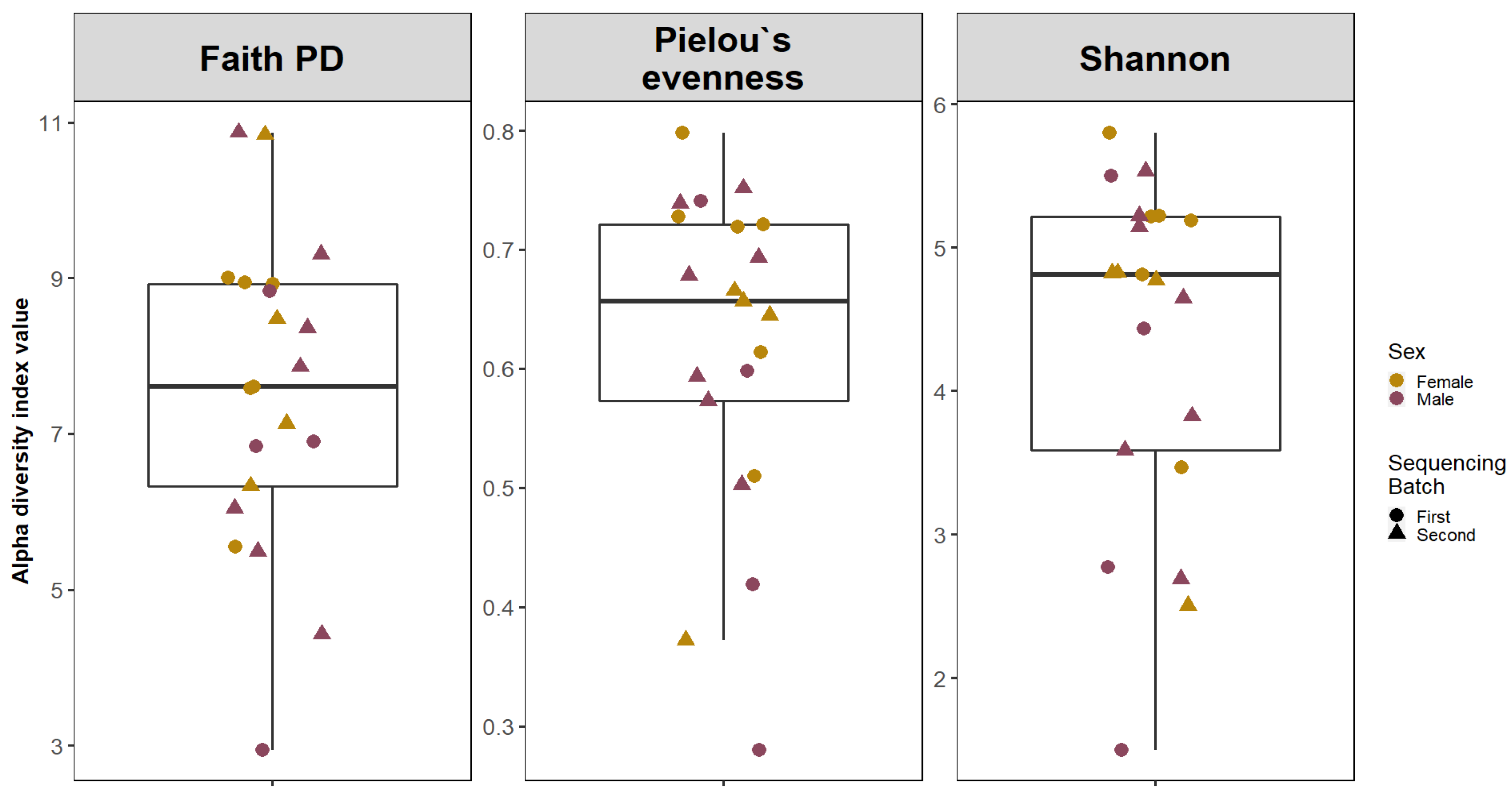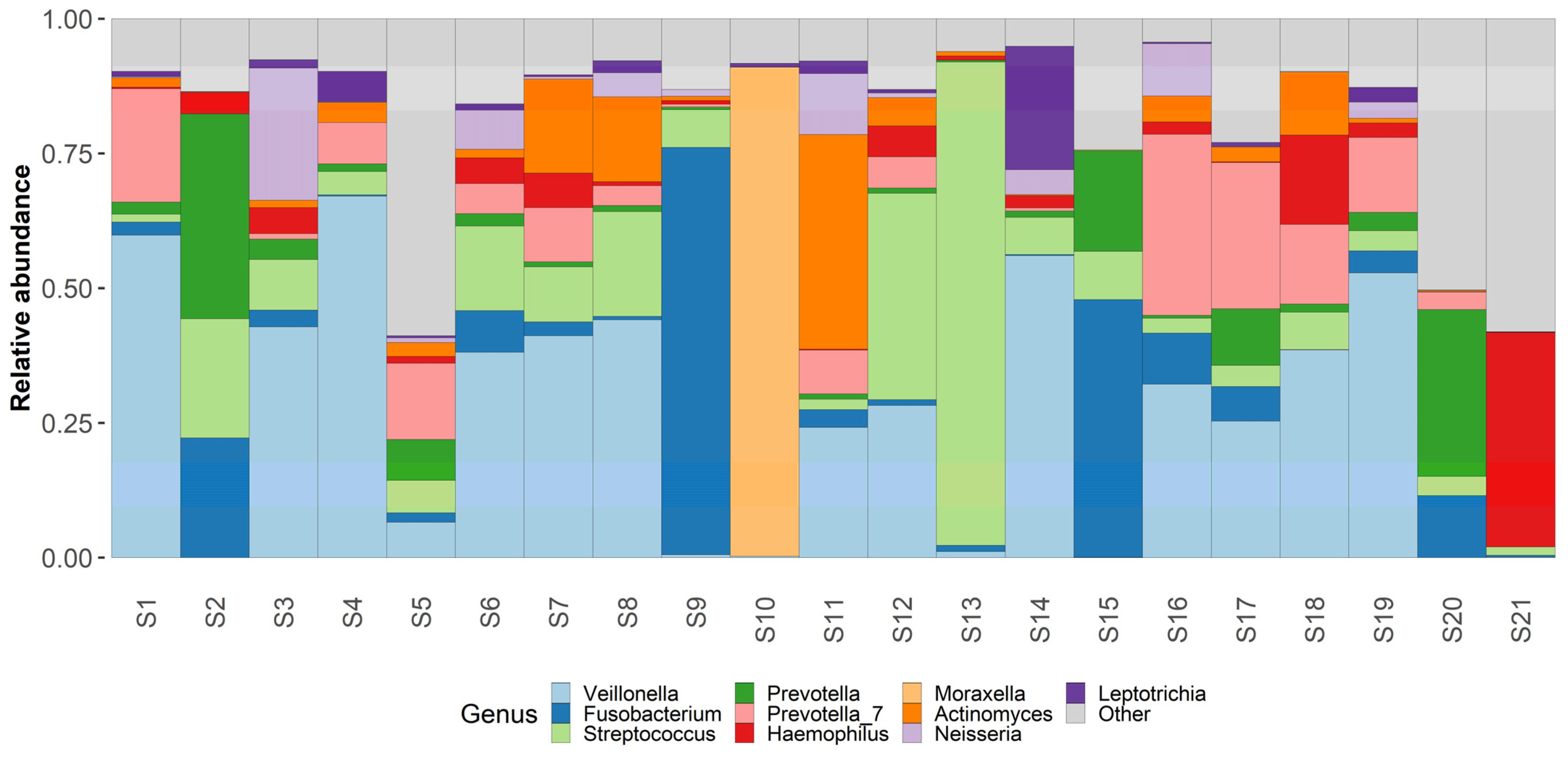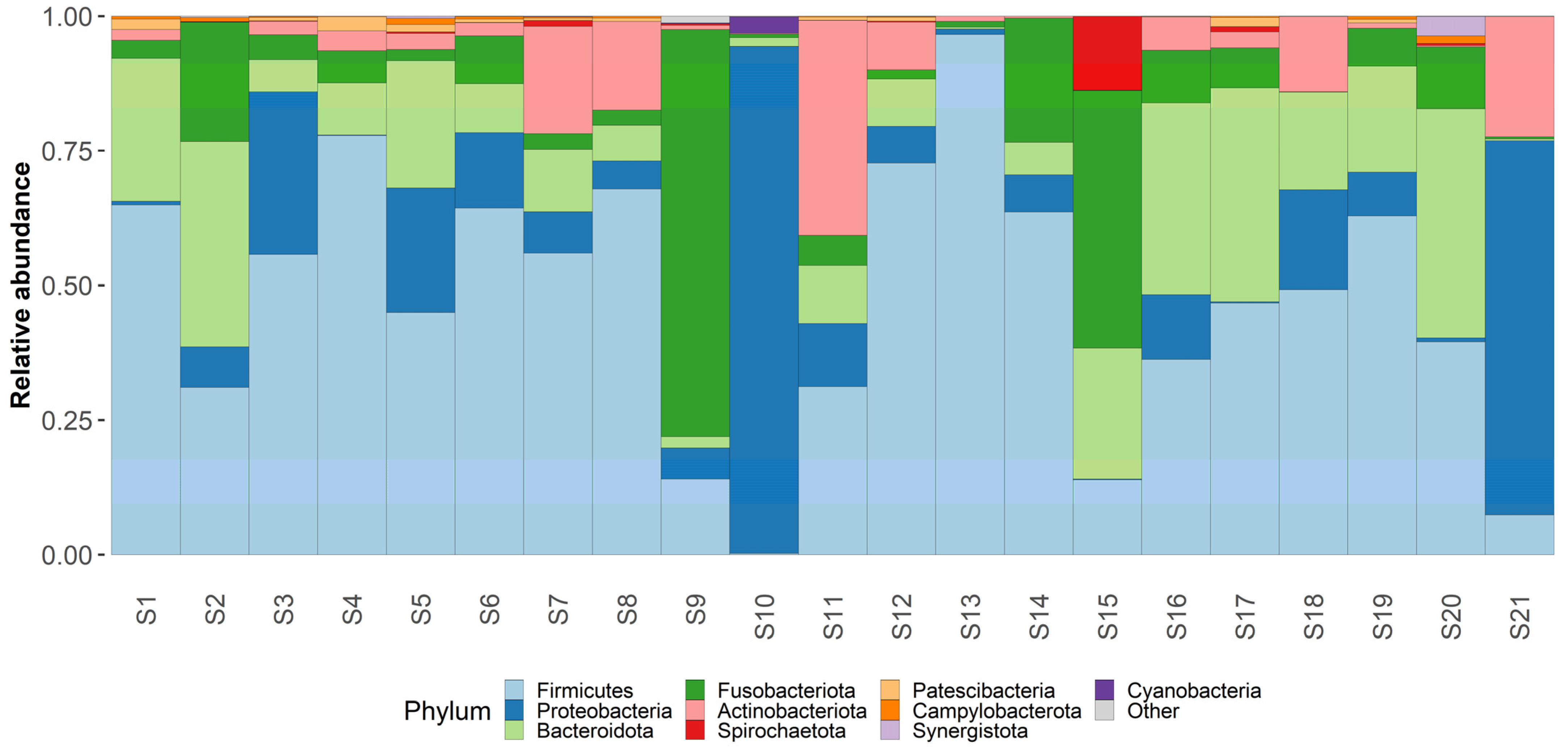An Overview of Adenoid Microbiome Using 16S rRNA Gene Sequencing-Based Metagenomic Analysis
Abstract
:1. Introduction
2. Materials and Methods
2.1. Ethics Statement
2.2. Patient Selection, Inclusion and Exclusion Criteria
2.2.1. Patient Inclusion Criteria
- Adenoid tissue collected from patients 2.5 to 6 years old.
- Indications for adenoid surgery—obstructive sleep apnea symptoms, recurrent upper airway infection, recurrent middle ear infections.
- Operation under general anesthesia.
- No evidence of middle ear fluid—A-type tympanogram.
- Endoscopically confirmed adenoid tissue in the nasopharynx blocking the choanas and/or eustachian tube openings.
2.2.2. Patient Exclusion Criteria
- Acute upper-airway infection during operation (including fever > 38.0 °C, purulent discharge from the nose, adenoid and tonsillar exudate, productive cough).
- Immunocompromised patients: HIV patients, diabetes mellitus patients, patients with tumors undergoing chemotherapy and/or radiotherapy.
- Patients with congenital cleft malformations.
- Patients receiving bacterial microflora-altering medications (for example -immune system stimulators).
2.3. Material Collection
2.4. Sample Processing and Sequencing
2.5. Data Analysis
2.6. Sample Collection Limitations
- Samples could only be collected from individuals (or their representatives) who agreed to paticipate in the study and signed a consent form. A significant amount of potential participants did not agree upon examining the consent form.
- To adequately perform a swab of the adenoid surface the adenoid tissue itself needs to be removed. Unlike swabs of other organic surfaces, which are easily accesible, a surgical operation is needed to collect adenoid surface swabs. This significantly limits our participant pool.
- Control groups consisting of “healthy’’ individuals, more precisely adenoid surface swabs of participants who have no previously mentioned symptoms is problematic. As stated, to acquire a uncontaminated adenoid surface swab the adenoid tissue needs to be removed, however, a healthy individual does not require an adenoid surgery. Another way to perform a swab of the adenoid surface is transnasaly, but this method has a high contamination risk. We should also keep in mind that the target population is children and any invasive procedures, such as swabs of areas of limited accessibility require complete anesthesia to prevent discomfort.
3. Results
3.1. Alpha and Beta Diversity
3.2. Taxonomic Analysis
4. Discussion
5. Conclusions
Supplementary Materials
Author Contributions
Funding
Institutional Review Board Statement
Informed Consent Statement
Data Availability Statement
Conflicts of Interest
References
- Man, W.H.; Peters, W.A.A.D.S.; Bogaert, D. The microbiota of the respiratory tract: Gatekeeper to respiratory health. Nat. Rev. Genet. 2017, 15, 259–270. [Google Scholar] [CrossRef] [PubMed]
- Buffie, C.G.; Pamer, E.G. Microbiota-mediated colonization resistance against intestinal pathogens. Nat. Rev. Immunol. 2013, 13, 790–801. [Google Scholar] [CrossRef] [Green Version]
- Marseglia, G.L.; Caimmi, D.; Pagella, F.; Matti, E.; Labó, E.; Licari, A.; Salpietro, A.; Pelizzo, G.; Castellazzi, A.M. Adenoids during childhood: The facts. Int. J. Immunopathol. Pharmacol. 2011, 24, 1–5. [Google Scholar] [CrossRef] [PubMed]
- Macassey, E.; Dawes, P. Biofilms and their role in otorhinolaryngological disease. J. Laryngol. Otol. 2008, 122, 1273–1278. [Google Scholar] [CrossRef] [PubMed]
- Donlan, R.M. Biofilms: Microbial life on surfaces. Emerg. Infect. Dis. 2002, 8, 881–890. [Google Scholar] [CrossRef]
- Hoa, M.; Syamal, M.; Schaeffer, M.A.; Sachdeva, L.; Berk, R.; Coticchia, J. Biofilms, and chronic otitis media: An initial exploration into the role of biofilms in the pathogenesis of chronic otitis media. Am. J. Otolaryngol. 2010, 4, 241–245. [Google Scholar] [CrossRef]
- Proctor, D.M.; Relman, D.A. The Landscape Ecology and Microbiota of the Human Nose, Mouth, and Throat. Cell Host Microbe 2017, 21, 421–432. [Google Scholar] [CrossRef] [Green Version]
- Kumpitsch, C.; Koskinen, K.; Schöpf, V.; Moissl-Eichinger, C. The microbiome of the upper respiratory tract in health and disease. BMC Biol. 2019, 17, 87. [Google Scholar] [CrossRef] [Green Version]
- Washington, J.A. Principles of Diagnosis. In Medical Microbiology, 4th ed.; Baron, S., Ed.; University of Texas Medical Branch at Galveston: Galveston, TX, USA, 1996; Chapter 10. [Google Scholar]
- Sontakke, S.; Cadenas, M.B.; Maggi, R.G.; Diniz, P.P.V.; Breitschwerdt, E.B. Use of broad range16s rdna PCR in clinical microbiology. J. Microbiol. Methods 2008, 21, 217–225. [Google Scholar] [CrossRef]
- Kim, S.K.; Hong, S.J.; Pak, K.H.; Hong, S.M. Analysis of the Microbiome in the Adenoids of Korean Children with Otitis Media with Effusion. J. Int. Adv. Otol. 2019, 15, 379–385. [Google Scholar] [CrossRef]
- Subtil, J.; Rodrigues, J.C.; Reis, L.; Freitas, L.; Filipe, J.; Santos, A.; Macor, C.; Duarte, A.; Jordao, L. Adenoid bacterial colonization in a paediatric population. Eur. Arch. Oto-Rhino-Laryngol. 2017, 274, 1933–1938. [Google Scholar] [CrossRef] [PubMed] [Green Version]
- Brennan, C.A.; Garrett, W.S. Fusobacterium nucleatum—Symbiont, opportunist, and oncobacterium. Nat. Rev. Microbiol. 2019, 17, 156–166. [Google Scholar] [CrossRef]
- Heckmann, J.G.; Lang, C.J.; Hartl, H.; Tomandl, B. Multiple brain abscesses caused by Fusobacterium nucleatum treated conservatively. Can. J. Neurol. Sci. 2003, 30, 266–268. [Google Scholar] [CrossRef] [PubMed]
- Brook, I. Veillonella infections in children. J. Clin. Microbiol. 1996, 34, 1283–1285. [Google Scholar] [CrossRef] [Green Version]
- Davcheva-Chakar, M.; Kaftandzhieva, A.; Zafirovska, B. Adenoid Vegetations—Reservoir of Bacteria for Chronic Otitis Media with Effusion and Chronic Rhinosinusitis. PRILOZI 2015, 36, 71–76. [Google Scholar] [CrossRef] [Green Version]
- Prates, M.; Tamashiro, E.; Proenca-Modena, J.L.; Criado, M.F.; Saturno, T.H.; Oliveira, A.S.; Buzatto, G.P.; Jesus, B.; Jacob, M.G.; Carenzi, L.R.; et al. The Relationship between Colonization by Moraxella catarrhalis and Tonsillar Hypertrophy. Can. J. Infect. Dis. Med. Microbiol. 2018, 2018, 5406467. [Google Scholar] [CrossRef] [Green Version]
- Lappan, R.; Imbrogno, K.; Sikazwe, C. A microbiome case-control study of recurrent acute otitis media identified potentially protective bacterial genera. BMC Microbiol. 2018, 18, 13. [Google Scholar] [CrossRef]
- Charbonneau, M.R.; Blanton, L.V.; DiGiulio, D.B.; Relman, D.A.; Lebrilla, C.B.; Mills, D.A.; Gordon, J.I. A microbial perspective of human developmental biology. Nature 2016, 535, 48–55. [Google Scholar] [CrossRef] [Green Version]
- Bosch, A.A.; Levin, E.; Van Houten, M.A.; Hasrat, R.; Kalkman, G.; Biesbroek, G.; Piters, W.A.A.D.S.; De Groot, P.-K.C.; Pernet, P.; Keijser, B.J.; et al. Development of Upper Respiratory Tract Microbiota in Infancy is Affected by Mode of Delivery. EBioMedicine 2016, 9, 336–345. [Google Scholar] [CrossRef] [PubMed] [Green Version]
- Brugger, S.D.; Eslami, S.M.; Pettigrew, M.M.; Escapa, I.F.; Henke, M.T.; Kong, Y.; Lemon, K.P. Dolosigranulum pigrum Cooperation and Competition in Human Nasal Microbiota. mSphere 2020, 5, e00852-20. [Google Scholar] [CrossRef]
- Stoodley, P.; Nistico, L.; Johnson, S.; Lasko, L.A.; Baratz, M.; Gahlot, V.; Ehrlich, G.D.; Kathju, S. Direct demonstration of viable Staphylococcus aureus biofilms in an infected total joint arthroplasty. A case report. J. Bone Jt. Surg. Am. Vol. 2008, 90, 1751. [Google Scholar] [CrossRef] [Green Version]
- Liu, C.M.; Cosetti, M.K.; Aziz, M.; Buchhagen, J.L.; Contente-Cuomo, T.L.; Price, L.B.; Keim, P.; Lalwani, A.K. The Otologic MicrobiomeA Study of the Bacterial Microbiota in a Pediatric Patient With Chronic Serous Otitis Media Using 16SrRNA Gene-Based Pyrosequencing. Arch. Otolaryngol. Head Neck Surg. 2011, 137, 664–668. [Google Scholar] [CrossRef] [PubMed] [Green Version]
- Ren, T.; Glatt, D.U.; Nguyen, T.N.; Allen, E.K.; Early, S.V.; Sale, M.; Winther, B.; Wu, M. 16S rRNA survey revealed complex bacterial communities and evidence of bacterial interference on human adenoids. Environ. Microbiol. 2013, 15, 535–547. [Google Scholar] [CrossRef]
- Morgado de Abreu, M.A.M.; Nai, G.A.; Molina, J.D.; Gomes, R.T.; Paula, N.; Roselino, A.M. Mycobacterium leprae on Palatine Tonsils and Adenoids of Asymptomatic Patients, Brazil. Emerg. Infect. Dis. 2020, 26, 2518–2520. [Google Scholar] [CrossRef]
- Fekete-Szabo, G.; Berenyi, I.; Gabriella, K.; Urban, E.; Nagy, E. Aerobic and anaerobic bacteriology of chronic adenoid disease in children. Int. J. Pediatric Otorhinolaryngol. 2010, 74, 1217–1220. [Google Scholar] [CrossRef]
- Frank, D.N.; Spiegelman, G.B.; Davis, W.; Wagner, E.; Lyons, E.; Pace, N.R. Culture-independent molecular analysis of microbial constituents of the healthy human outer ear. J. Clin. Microbiol. 2003, 41, 295–303. [Google Scholar] [CrossRef] [PubMed] [Green Version]
- Jervis-Bardy, J.; Rogers, G.B.; Morris, P.S.; Smith-Vaughan, H.C.; Nosworthy, E.; Leong, L.E.X.; Smith, R.J.; Weyrich, L.S.; De Haan, J.; Carney, A.S.; et al. The microbiome of otitis media with effusion in Indigenous Australian children. Int. J. Pediatr. Otorhinolaryngol. 2015, 79, 1548–1555. [Google Scholar] [CrossRef]




Publisher’s Note: MDPI stays neutral with regard to jurisdictional claims in published maps and institutional affiliations. |
© 2022 by the authors. Licensee MDPI, Basel, Switzerland. This article is an open access article distributed under the terms and conditions of the Creative Commons Attribution (CC BY) license (https://creativecommons.org/licenses/by/4.0/).
Share and Cite
Sokolovs-Karijs, O.; Brīvība, M.; Saksis, R.; Sumeraga, G.; Girotto, F.; Erts, R.; Osīte, J.; Krūmiņa, A. An Overview of Adenoid Microbiome Using 16S rRNA Gene Sequencing-Based Metagenomic Analysis. Medicina 2022, 58, 920. https://doi.org/10.3390/medicina58070920
Sokolovs-Karijs O, Brīvība M, Saksis R, Sumeraga G, Girotto F, Erts R, Osīte J, Krūmiņa A. An Overview of Adenoid Microbiome Using 16S rRNA Gene Sequencing-Based Metagenomic Analysis. Medicina. 2022; 58(7):920. https://doi.org/10.3390/medicina58070920
Chicago/Turabian StyleSokolovs-Karijs, Oļegs, Monta Brīvība, Rihards Saksis, Gunta Sumeraga, Francesca Girotto, Renārs Erts, Jana Osīte, and Angelika Krūmiņa. 2022. "An Overview of Adenoid Microbiome Using 16S rRNA Gene Sequencing-Based Metagenomic Analysis" Medicina 58, no. 7: 920. https://doi.org/10.3390/medicina58070920
APA StyleSokolovs-Karijs, O., Brīvība, M., Saksis, R., Sumeraga, G., Girotto, F., Erts, R., Osīte, J., & Krūmiņa, A. (2022). An Overview of Adenoid Microbiome Using 16S rRNA Gene Sequencing-Based Metagenomic Analysis. Medicina, 58(7), 920. https://doi.org/10.3390/medicina58070920





